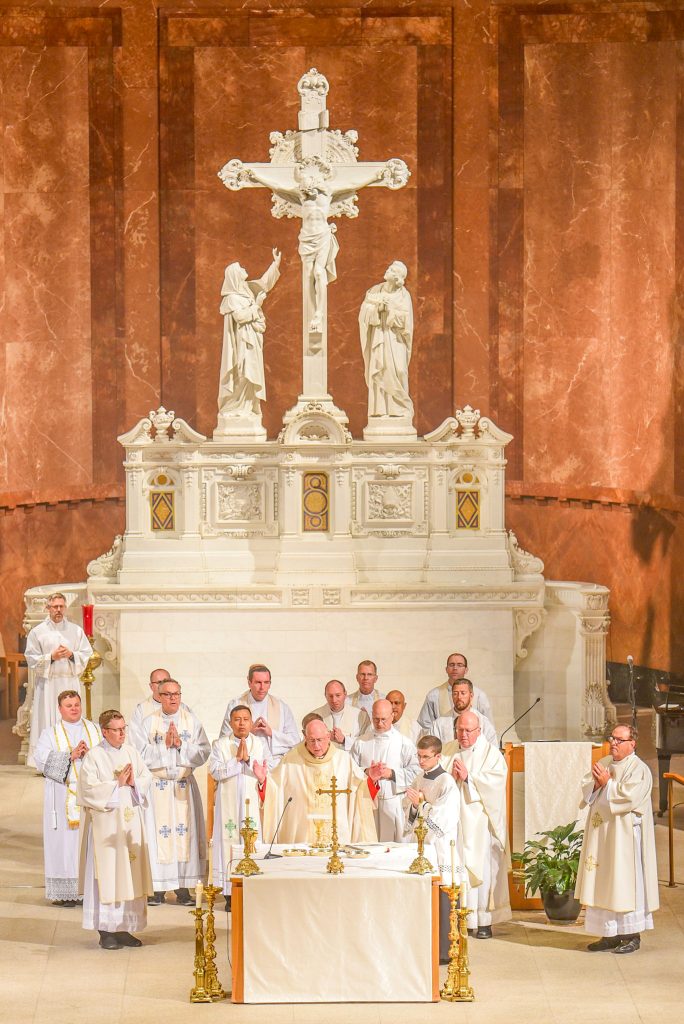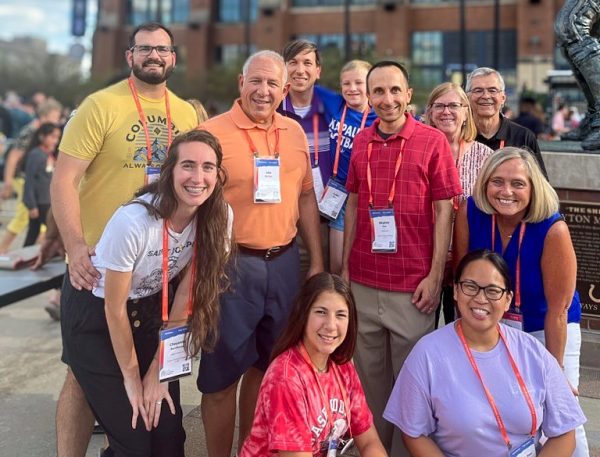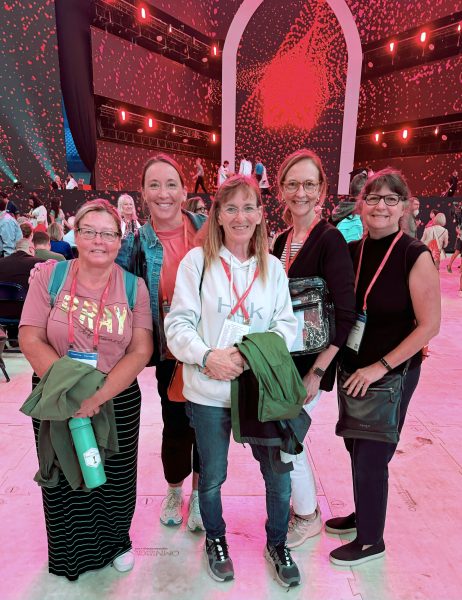Diocesan pilgrims reflect on National Eucharistic Congress

About 60,000 pilgrims took part in the National Eucharistic Congress July 17-21 in Indianapolis.
The Congress was an event of the National Eucharistic Revival, a three-year initiative sponsored by the bishops of the United States. The revival’s purpose is to inspire and prepare the faithful to be formed, healed, converted, united, and sent out to a hurting world through a renewed encounter with Jesus in the Eucharist – the source and summit of our Catholic faith.
Many from the Diocese of Wichita attended the Eucharistic Congress and each had a unique experience.
Jake Samour: Congress was a great moment for the church
Jake Samour said the National Eucharistic Congress was a great moment for the church in the United States.
“One thing that stuck out for me is you can’t have revival without some sort of healing and repentance – that’s how you renew,” he said. “That was some of the focus in the evening sessions: How do we renew the church in the United States? Well, we start with ourselves and repent with hope and joy, not in a negative way, but in a way that is going to bring renewal to the church.”

Samour, the director of the Office of Marriage and Family Life, said the event was an amazing production centered around the Eucharist and meeting Jesus in the Blessed Sacrament at Mass.
“To be there with 60,000 people was an incredible experience for everyone who attended. There was a sense of joy and everyone I talked to said they were experiencing something profound throughout those days.”
He said others he met at the Congress from the Diocese of Wichita had a sense of being renewed and refreshed, and of being sent to be missionary disciples.
“In the final homily, Cardinal (Luis Antonio) Tagle from the Philippines mentioned that you cannot be a missionary disciple if you’re not a gift to others,” Samour said. “The gift we received while we were there and the healing and joy we experienced there, we need to take that out into the world.”
That’s what the pilgrims from the diocese took from the Congress, he said. “That goes along with what the diocesan Pastoral Plan is: to be fully alive and to preach the Gospel to everybody. That was the key for the 60,000 people that went and the pilgrims from our diocese, to be that seed that’s planted to renew our dioceses all together as a nation.”
Samour said he didn’t think he had low expectations about the Congress but that he was “blown away by the vastness, the greatness of it all. It was a great moment. To see the face of the church come alive. Young and old together, praying and praising the Lord, it was a unique experience.”

Fr. Lies was a little nervous
The Very Rev. David Lies had some anxiety leading up to the event.
“As an introvert, it takes a lot of energy for me to immerse myself in so many people in such large events, knowing that a lot of times they’ll be waiting to prepare for events or moving through a large area, like a convention center, to get to places,” he said. “I have to shamefully admit I didn’t have a lot of enthusiasm initially. But I felt it was important for me as vicar general to support the bishop with my presence. So that initially was my motivation for going.”
But as the day for boarding the bus to Indianapolis drew nearer, Fr. Lies said, he began feeling a little more open to participating.
“The Lord can do anything for one person – even in the midst of thousands of people,” he said. “I kept that in mind and had an overall sense of peace from the 12-hour bus trip to Indianapolis to the process of getting to the hotel and registering, and even getting to the very first opening event of the evening, on Wednesday, when we had arrived rather close to time.”
Mobile Mass
The mobile Mass on the bus may have contributed to his sense of peace.
The bus left at 4:15 a.m. Wednesday, a bit early for a private Mass, he said. After checking with the pilgrims after a stop in Kansas City, none of whom were able to attend Mass, he considered celebrating a Mass on the bus.
He consulted Bishop Carl A. Kemme about his idea. “We worked out that a priest can say Mass on a cruise ship or a train, so somewhere between Kansas City and Columbia, Missouri, on I-70, we celebrated the Eucharist. I prayed for both Bishop (James) Johnson and Bishop (Shawn) McKnight, not knowing what diocese I was in. Everybody on board was very grateful for that and I can chalk that up as a first for me as a priest.”
After their arrival, Fr. Lies said, “I put myself in the Lord’s hands and felt him leading me through all the places I had to go, and so it was, I would say a very consoling, spiritual experience.”
He found it remarkable that with the tens of thousands of participants at various events and at the Lucas Oil Stadium, he never got the sense that people were getting frustrated or impatient. “And to see so many people who believed in the Eucharist, who were there to encounter the Lord, who were opening themselves up to the possibility of that grace, was very inspiring and encouraging.”
Catholics can change the country
At Saturday night’s closing address, Fr. Lies said, the Most Rev. Robert Barron, bishop of the Diocese of Winona-Rochester, Minnesota, reminded those attending that there are 70 million Catholics in the United States and that if they had the same desire to encounter the Lord as the 60,000 attending the Congress, it would change the country.
“For me, personally as a priest, to concelebrate Masses with nearly 1,000 other priests and to see so many bishops as well as deacons and seminarians and an abundance of religious sisters, for my own vocation, that was very encouraging,” he said.
The beauty of religious life
Fr. Lies added that he got a kick out of seeing all of the different religious sisters’ habits of attire. “I kind of wanted at one point to get photos with every one of them I encountered. It’s beautiful to see the female religious life expressed so visibly in that way.”
In one of Fr. Michael Schmitz’s talks, he said, the priest from the Diocese of Duluth, Minnesota, quotes the Book of Revelation in commending the Church of Ephesus for holding fast to the faith during persecution and for not promoting anything contrary to the Gospel.
“But I have this to hold against you, that you have forgotten your first love,” he said continuing to quote Revelation. “And so Father Schmitz spoke about how have we forgotten our first loves. Or, if you will, that early fire for the faith that we had, and then he offered the point of reflection of what are the ‘fire extinguishers’ in our lives.
A personal reflection
“What are my personal habits or ways of thinking that extinguish that fire of faith, the love for the Lord? That was mildly convicting. I did a little examination of conscience, and in coming back from the Congress, I made a list of those things like, how will I respond differently? What are those creature comforts or pastimes or ways of entertaining myself that really don’t enhance my faith or my relationship with the Lord? So, personally, that’s how I benefited from that.”
Fr. Lies said after talking to other pilgrims from the diocese and with Bishop Kemme he had an overall sense of the Holy Spirit at work.
“I’m very glad that I participated in such a historic moment for the church in America. I’m praying now that each one of us as participants goes out as little sparks back to our home dioceses, our home parishes, or other places of life, and tries to ignite a few other people that can be impacted positively by our own witness of the event.”
Fr. Greer: An experience behind the scenes
Fr. Gabriel Greer’s experience of the National Eucharistic Congress was different than most. “Most of the people from the diocese went as pilgrims, to attend talks and liturgies,” he said. “That’s how I was originally going, but I was asked in January to be on the liturgy team to assist with the liturgies in Spanish.” There were 18 liturgies celebrated over the course of five days and at times, there were three or five liturgies. It took many hands to facilitate each of these liturgies. I spent a lot of time backstage assisting with the liturgies and onstage as the M.C. for the Spanish liturgies.”
Fr. Greer was the master of ceremonies for the Masses celebrated by Cardinal Seán O’Malley of Boston, Archbishop Nelson Perez of Philadelphia, and Archbishop José Gómez of Los Angeles. “Needless to say, I experienced the congress differently.”
Fr. Greer, the rector of the Cathedral of the Immaculate Conception and director of Worship for the diocese, said it was exciting to see the tens of thousands of pilgrims. “There were so many people. I only saw one or two people from our group, even though I was frequently walking through the halls.”
Sent out as missionaries
He said he hopes the pilgrims were able to capture the energy of the event as the next phase of the Eucharistic revival begins: being sent out to be missionaries of the Eucharist.
“I think it’s very important that we go out and take the love of Christ that we have experienced through the Eucharist, and we take that love and share it with others. I think that’s very, very important in this next stage.”
Cardinal Christophe Pierre set that vision on the first night, Fr. Greer said, when the papal nuncio to the United States said that the love and the encounter we have with the Eucharist is meant to be shared.
“There’s so much power if we as Catholics do that. We have power to take Christ to others. We have power to see Christ in others. We have power to be witnesses of the Gospel, and that’s what will change the world,” Fr. Greer said.
The Eucharist strengthens the faithful in those moments, he said. “But it’s only through the Eucharist, that source and summit of our faith, the source and summit of our life in the church, that will transform us and transform the world.”
Ronnfeldt took a ‘team’ with her
Audrey Ronnfeldt, the director of the Stewardship Office, drove the 680 miles to Indianapolis with three members of her Stewardship Works Leadership Team.
She said the group was blessed even before arriving in Indianapolis because they stopped in St. Louis where they were given a private tour of the Cathedral Basilica of St. Louis. “On our way, we had been discussing how hard it was to leave family for a week, how big the crowds were going to be – there was a little angst. The tour guide showed where Pope JP II had prayed 30 years before for World Youth Day. He shared those famous words: ‘Be Not Afraid.’”
During the trip they were able to listen to a presentation from the Hallow Prayer App “Witness to Hope” during which World Youth Day 30 years ago was mentioned and again his famous words “Be Not Afraid”. The presentation was related to what the four pilgrims in the car were feeling and doing, she said.
‘Stunned silent’
“We were stunned silent,” Ronnfeldt said. “It was one of those Holy Spirit moments. We are called to ask God what do you want from us? That was one of the conversations we had in the car.”
The Congress was a welcome respite from meetings and office work, she said. “I needed a spiritual renewal – a break. So, for me personally, I was able to see a great number of people: to really feel the presence of the Holy Spirit, in their joy and the peace that surrounds you – with all those people, and you still feel peace.”
All of the events featured prayer, praise, and worship, Ronnfeldt said. During one session they were asked to put their hands on another pilgrim, if they didn’t mind. Moments later she heard someone sobbing. One of those in her group was praying out loud for a man.
“She shared with us afterward: ‘I don’t know how this all happened if it wasn’t the Holy Spirit,’” Ronnfeldt said.
The man she prayed for brought a friend who was an atheist but was open to attending the event, she said.
“He said, ‘I’ve been praying so much for him that I hadn’t been praying for myself.’ Things like that were happening all the time.”
Everyone was impressed with the presentation of the events, she said. The first evening session featured the representative saints that had been carried on the walking pilgrimages from the four corners of the United States. They were placed on the four corners of the altar where the monstrance was going to be placed.
A powerful moment
“And then they brought in Jesus. It was stunning,” she said. “They explained how many miles that each of them had traveled to get there. What an amazing opportunity to be able to witness. It was very powerful.”
Ronnfeldt kept a journal. One thought she wrote down was from Sr. Mary Grace Langrell. “She said in the Eucharist we find the greatest measure of our worth. And she said a soul at peace will save 1,000 souls. I thought that was so beautiful. The Eucharist satisfies the ache for love that we cannot satisfy ourselves.”
The executive team of the Congress reminded the pilgrims that they were not attending “an event,” Ronnfeldt said. “They talked about the pillars, the Eucharistic pillars: Eucharistic encounter, Eucharistic identity, Eucharistic life, and Eucharistic mission. So it’s about a fire and not a program. It’s a playbook, but not a manual. The National Eucharistic Revival is not over. It is just beginning. We are entering into a new Eucharistic Missionary era.”
Their point was to take the “fire” with them to their dioceses, she said. “So how do you keep this alive? How do you stay connected so that the coals that are burning in the fire that’s burning with you, aren’t extinguished?”
Don’t extinguish the ‘fire’
One of the speakers talked about aspects of our lives that extinguish the fire of the Holy Spirit, Ronnfeldt said, to be aware of them, and not allow them to redirect them from the mission.
She added that she had attended many conferences, “but this was the first one for me that I felt and saw life-transformation happening. And it was really about the spirit and the presence of the Spirit.”
Ronnfeldt said she and her group brought the spirit of the event back to Wichita and will incorporate it into their work group.
“You don’t have to have attended the congress to be on mission!” she said.
For more information about the Year of Mission visit eucharisticrevival.org/year-of-mission.
